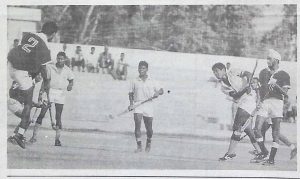
Gian Singh a noted coach and international umpire, dwells on the changes that changed the face of the game, of hockey
It is essential that there must be rules to ‘protect the players from any danger in a ‘game like hockey. In a game of skill there ‘must also be rules to penalize any player obtaining an unfair advantage over an ‘opponent. The originators of the game made a set of rules. These have been ‘amended, altered, modified, deleted and ‘even buried in some cases to meet the exigencies of time.
The dimensions of the field and its marking underwent a series of modifications and until 1885 goal scoring was a pertly haphazard affair. The length of the ground used to be at least 200 yards long and 60 yards wide. Afterwards it was reduced to a length of 100 yards as of today. The longer boundary lines are called the sidelines and the shorter the back lines except that part of the back line between the goalposts called goal line.
All the lines are three inches wide and their width is included in the field of play as ‘such the ball remains inside the field of plays long as any portion of the ball is touching the line.
Goalposts: There were no goalposts in olden days when the game used to be played between two teams without any restriction (on the number of players on each side. But in 1862 the length of the ground was fixed at 200 yards and the goal poles to be 10 yards apart Today the goalposts consist of two perpendicular posts four years apart, joined together by a horizontal cross bar seven feet from the ground, the front base of the goal ‘posts touching the outer edge of the backline, Till 1896 the top of the goalposts were Joined by a tape. The rule has since been ‘changed and the crossbar cannot be substituted even in an emergency. Players should know that if the ball strikes the face of the goalposts or the crossbar or the corner flag post and rebounds into the field of play, it is still inside the field of play.
Weight of stick: The stick must not weigh more than 28 ounces and less than 12 ounces. It must have a flat face on its left hand side and has 10 pass through a two inch ring inclusive of surgical binding, if any. A player can only use the flat side of the stick, from the lowest part of the flat side should not exceed four inches.
It is interesting 10 know that in 1952 Helsinki Olympics, Poland successfully protested against Belgium on the sticks they used which failed to go through a two inch ring: Poland defeated Belgium 10 in the replay. Belgium had won the first game 4-3.
1 was Teddington Club which introduced the Circle in 1876 when it played Surbiton at Bushby Park. This was the first ‘game to be played with the Circle and or the “D” as it may be called and of course it brought about a revolutionary change as regards the rules of shooting at goal. Prior to this the teams used the 15 yards line drawn parallel from each goalpost. A further change came in 1950 when the radius of the circle was increased by 16 yards in the hope that scoring rate will increase. The nets came to be used in 1891, it is essential that the ball must be inside the circle before the striker takes a shot for a goal. The striker should ensure that ball is within the circle. The ball must also cross the goal line to be declared a goal. If the ball after being hit within the circle touches the stick or a defender or defenders, before entering the goal, it is also deemed a goal.
Article extracted from this publication >> October 13, 1989